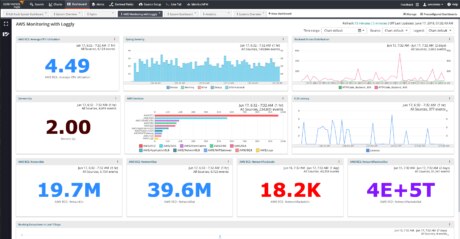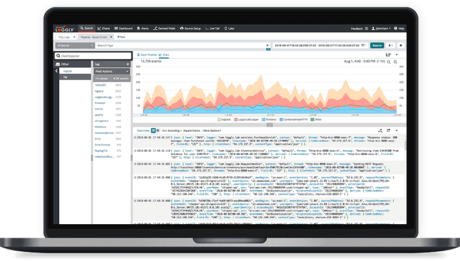Technical Resources
Educational Resources
APM Integrated Experience
Connect with Us
Effective log management can help tech pros monitor their applications and improve performance.
Log management is the practice of collecting, formatting, aggregating, and analyzing log data to optimize programs and applications. Log data contains valuable information capable of informing tech pros about application performance and helping them catch issues. With a better understanding of performance, techies can allocate the appropriate resources to improve the end-user experience. However, effective log management requires an investment of time and money, and users may wonder whether it’s worth it. The right log management tools can save hours of manual log viewing and offer important insights beneficial to anyone who wants to better manage their applications.

Log management starts with bringing together data from applications, services, hosts, and more. The log data is a record of events taking place over time across various applications and infrastructures. Because these logs come from different sources and exist in varied formats, a log manager needs to parse them into individual data points to standardize their format. Once they’re parsed and centralized, tech pros can then extract valuable information they can use to analyze and improve application performance.
The many log files generated from devices and software offer critical insights, but event logs lead to high volumes of data because they’re continually generated. Tech pros may struggle to organize these logs in a timely way. Even when they aggregate all this data, tech teams must be able to run advanced searches for logs. This can be difficult to do without the proper tools, since logs may have different syntaxes or tags and often require unique queries. As challenging as it can be to manage event logs, it’s bad practice to ignore them. Tech pros need to use a log management tool to help collect, store, and archive these large volumes of log data.
Log management is important for several reasons, but its major benefit is helping tech pros optimize application performance and improve resource allocation. Log monitoring tools can be deployed to monitor code in parts of programs tech pros might not always be able to fully access. This process can also help admins catch issues before they impact users. For example, log insights might help a developer identify bugs or missing code when an application error occurs. Additionally, log management software can be a useful resource for less tech-savvy project managers. These managers can use it to convert difficult data into an easy-to-understand format for performance reports.
The biggest challenge with logs, however, is the overwhelming amount of data. In many cases, tech pros aren’t actively analyzing and mining the data gathered in logs. It’s understandable why—no one wants to manually review a high volume of logs each day. But since event data can be the first sign a key application or service is running out of resources or experiencing a spike in demand, it’s important for businesses to invest in proper log management tools and best practices to make sure they’re getting the most out of their data.
Log management software can automate many of the tedious tasks involved in event log management. Some businesses might make the mistake of trying to build their own log monitoring infrastructures, but this isn’t recommended if time and cost are a concern. There are plenty of affordable vendor log management tools providing value right off the shelf.
Centralized log management is the act of moving all log data into one central, accessible location. Having all logs collected in one location makes log management easier. Centralized logging tools can help you organize data from different sources, search for specific logs, and enforce retention policies so logs remain available during specific times. In addition, centralized logging makes sharing log data easier so you can share it with other business associates.
It’s important to plan so you know what you need to monitor and what you don’t. Businesses often make the mistake of believing something should be logged simply because it can be. This will have a negative effect on your log management practice, since logging too many data points can make it harder to find the most important data. It also adds complexity (and costs) to your log storage.
On the other hand, it’s important to log any type of production environment data critical for daily workflows or application development. Likewise, you should log any data helpful for troubleshooting performance problems or solving user experience issues. The information from these logs can provide direct value in your day-to-day operations.
Log data often contains sensitive information, so it’s important for organizations to select a service offering tech pros complete control over their data. The first step for tech teams hoping to keep their data secure is to ensure they’re using a secure data transmission service. Enhanced transfer protocols allow tech pros to encrypt all sensitive log data before they send files to a trusted partner. Other important security features include secure accounts and role-based access control. With these features, users can be assigned login credentials and tech pros can set unique permissions to keep their data safe and monitored.
Log data tends to take up space, and this can be exacerbated further when critical system errors arise and accelerate log file growth due to increased error rates. This unpredictability is expensive and a headache for tech teams to manage manually. It’s advisable for businesses to invest in a hosted cloud solution capable of automatically scaling to save time and money when log generation fluctuates.

As you consider the right log management service for your business needs, it’s important to choose a tool as robust as it is reliable. SolarWinds® Loggly® is one of these tools. With Loggly, IT teams can collect, aggregate, and analyze log output across their network and applications.
Loggly offers a state-of-the-art search tool designed to optimize log queries over large data sets, saving tech pros time and improving the speed at which application errors can be identified and solved. The automated cloud-hosting Loggly offers also dynamically scales as needed, so organizations don’t need to worry about wasting resources on unpredictable storage bills. Additionally, organizations can get built-in security for their log data with Loggly’s detailed access control features. Learn more about Loggly by visiting our product page today.